by W.R. Jacobi* (12/13)
Quick Facts…
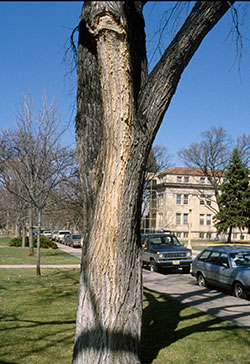 |
Figure 1. Discoloration of bark of American elm affected with wetwood. (W.R. Jacobi). |
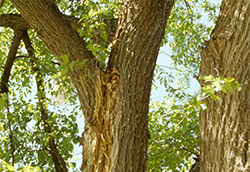 |
Figure 2. Wetwood discoloration at branch crotch on American elm. (W.R. Jacobi). |
- Bacterial wetwood is a common disease that affects the central core or bark of many shade and forest trees.
- Slime is the exudate generated from fermentation pressure in wetwood affected trees and is toxic to growing areas of the tree.
- Several insects commonly feed on this slime.
- Wetwood-infected tissue only slightly alters the wood strength of most trees.
- Prevention of tree stress is the best management approach. Effective control measures do not exist.
Bacterial wetwood (bacterial slime, slime flux) is a common disease that affects the central core of many shade and forest trees. In Colorado, the disease is most prevalent in aspen, cottonwood, elm and willow. The disease also affects species of apple, ash, birch, cherry, fir, honeylocust, linden, maple, oak, sycamore, plum, and poplars.
Alcohol flux is a similar disease but is characterized by a milky frothy ooze and sweet alcohol smelling infection of the bark. This disease is most commonly seen on poplars and globe willow in Colorado.
Causal Organism
Several bacteria, including species of Enterobacter, Klebsiella and Pseudomonas, often are associated with wetwood. It has not been conclusively demonstrated that these bacteria cause the disease, but they seem directly involved. The cause of alcohol flux is not known, but is assumed to be yeast because of the production of ethanol (alcohol).
Symptoms
Symptoms of wetwood disorder include a yellow-brown discoloration of the wood, generally confined to the central core of the tree. This affected wood is wetter than surrounding wood and is under high internal gas pressure. The buildup of gas pressure is a by-product of bacterial activity. In elms, the gas consists mainly of methane and nitrogen. The highest gas pressure occurs in elms from May through August. The gas pressure and high moisture content cause an oozing or bleeding of slime, from pruning cuts, through bark cracks and branch crotches. The ooze is foul-smelling, slimy, and colonized by yeast organisms when exposed to air. When the slime dries, it leaves a light gray to white crust on the bark. Orange shinny ooze coming from a single point on aspens is usually from insect borer damage not wetwood.

Figure 3. Old pruning cut with wetwood slime inhibiting callus growth. (W.R. Jacobi). |
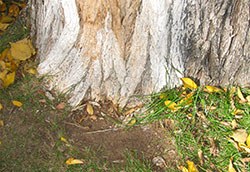
Figure 4. Base of tree where wetwood slime has killed the grass. (W.R. Jacobi). |
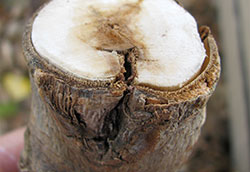
Figure 5. Wet wood induced canker on a nursery grown cottonwood. (W. R. Jacobi). |
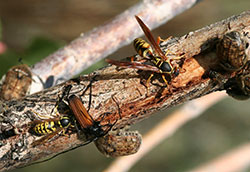
Figure 6. Wetwood or alcohol flux slime with visiting wasps and bumble flower beetles. (W. Cranshaw). |
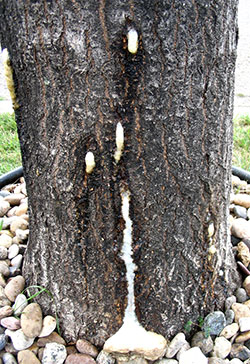
Figure 7. White ash with milky alcohol flux. (J. Walla). |
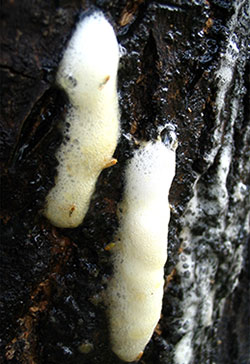
Figure 8. Milky froth of alcohol flux. (J. Walla). |
Wetwood slime is toxic to the tree’s cambium, the tissue between the inner bark and wood that produces new cells. Slime can prevent or retard callus formation when the tree has been wounded or destroy the cambium at the base of a pruning cut. Foliage, young shoots and grass die if slime flux drips on them. Root tissue also can exhibit wetwood symptoms as brown streaks extending from the diseased trunk into the center core and sometimes the outer wood of roots. Radial cracks may also occur in wetwood-affected trees (Figure 1). These cracks probably develop during winter months. If the cracks extend to the cambium, they serve as avenues for slime and gas to escape. The slime will also kill the surrounding cambium. Cambial wetwood or surface wetwood apparently is a variation of wetwood where the disease is located in the cambium and kills the cambium causing cankers. The xylem is discolored between the central core of wet wood and the cambium so it is assumed these disease symptoms are related to the same cause.
Wetwood-infected tissue slightly alters the strength properties of the wood. However, it inhibits the development of wood-rotting fungi, which are unable to grow in the affected wood because of lower oxygen content. Wetwood also causes warpage and splitting problems when boards cut from affected trees are dried.
Alcohol flux symptoms can occur just under the bark as dark streaks in the cambium or current season’s wood. White milky foam is commonly seen in affected areas. These disease symptoms are common on drought-stressed trees especially cottonwoods and globe willows.
Transmission
Bacteria associated with wetwood are common in soil and water and probably enter trees while still young through root wounds. Where oozing occurs, the bacteria could be transferred to a new stem or branch wounds. Wetwood also may occur in seedlings that develop from infected seeds or from infected parent material in vegetatively propagated plants. Insect transmission of either wetwood or alcohol flux organisms has not been demonstrated.
Management
No effective methods exist to eliminate wetwood disease. Preventing damage and stress to a tree’s roots and stem is the best way to avoid a serious wetwood problem. Drought conditions increase wetwood impact on the tree and can lead to cambial death. Thus, it is important that the tree receives adequate water, especially during spring and summer months.
Recently transplanted trees may ooze slime or have alcohol flux if roots are not established and cannot supply adequate water. Fertilizing wetwood-infected trees is only recommended if the tree shows nutrient deficiencies.
To help prevent disease spread within an infected tree, keep any injection holes shallow so they do not reach the inner wetwood core. If they do reach this core, the bacteria can spread outward. Drain tubes are not recommended since these drill holes allow the bacteria to spread outward. This practice also introduces more oxygen into the tree’s system and can possibly allow wood decay.
In trees affected just below the bark with cambial wetwood or alcohol flux, cut away the dead bark areas to allow for better wound closure. Remove discolored bark down to the wood and margins of the healthy yellow-green cambium. If this area exceeds 40 percent to 50 percent of the trunk circumference, the tree may not close the wound or be an aesthetically pleasing tree. If, however, the area is small, shape the bark removal with clean, smooth edges.
Associated Insects
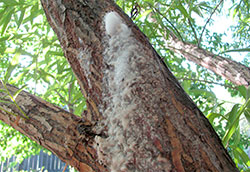
Figure 9. Globe willow with alcohol flux. (W.R. Jacobi). |
Several insects commonly visit the oozing slime or alcohol flux and feed on it. Various flies and sap beetles often are seen on the slime. Larval stages of these Insects may develop within the wounded area. Among the most striking Insects that visit oozing slime are bumble flower beetles, a hairy species of June beetle that sometimes clusters in large numbers. None of the insects that visit slime flux wounds are known to transmit the bacteria and there is no need to control them. Alcohol flux attracts wasps and bees which can be a nuisance to people allergic to wasp/bee stings.
*Colorado State University professor, bioagricultural sciences and pest management.7/98. Revised 12/13.
Colorado State University, U.S. Department of Agriculture and Colorado counties cooperating. CSU Extension programs are available to all without discrimination. No endorsement of products mentioned is intended nor is criticism implied of products not mentioned.
Go to top of this page.





